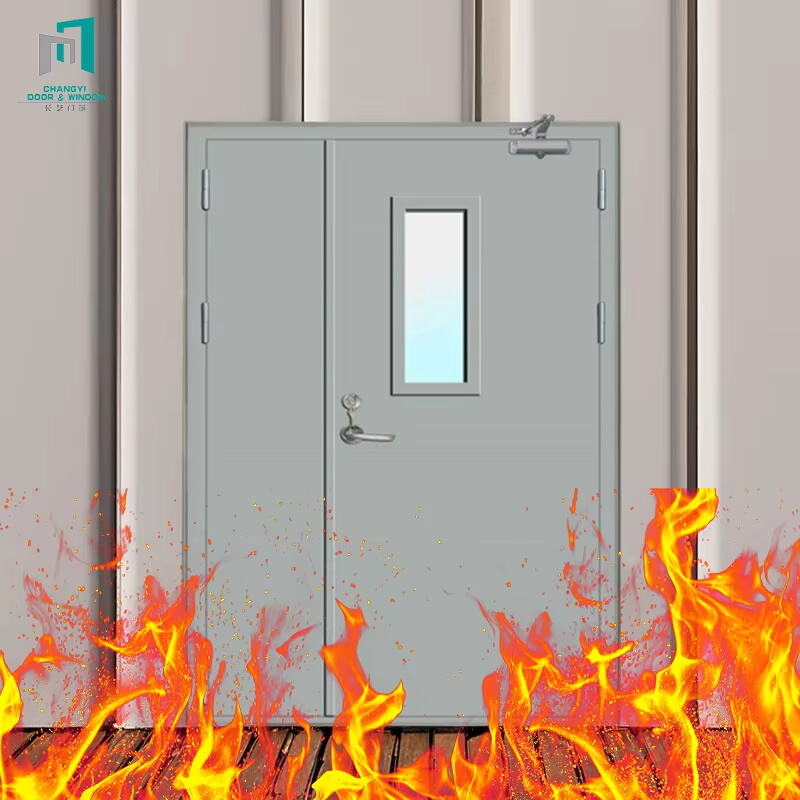Pendahuluan: Tinjauan singkat tentang peran pintu anti api dalam menyelamatkan nyawa.
Pintu tahan api memainkan peran yang sangat penting dalam sistem keselamatan kebakaran di setiap bangunan. Pintu ini pada dasarnya merupakan penghalang kuat yang mencegah api dan asap menyebar di dalam struktur bangunan. Pintu-pintu ini menjaga keselamatan orang dengan memerangkap api di tempat mulainya, memberikan waktu lebih bagi orang untuk keluar, serta mengurangi tingkat kerusakan yang terjadi pada bangunan itu sendiri. Beberapa angka penting yang perlu dicatat: pintu tahan api dapat benar-benar menghalangi api selama periode waktu antara 20 menit hingga 120 menit dalam beberapa kasus. Perlindungan semacam ini bisa secara harfiah menyelamatkan nyawa. Kebanyakan tempat memiliki peraturan hukum yang mewajibkan penggunaan pintu ini di rumah, kantor, pabrik, dan jenis bangunan lainnya sesuai dengan kode bangunan setempat. Alasannya? Karena otoritas terkait mengakui betapa krusialnya peran pintu ini dalam keselamatan secara keseluruhan. Saat bangunan mematuhi aturan-aturan ini mengenai pemasangan pintu tahan api yang tepat, artinya semua orang yang berada di dalam bangunan memiliki peluang yang lebih besar untuk selamat ketika terjadi sesuatu yang tidak diinginkan.
Apa itu Standar UL dan CE?
Dalam hal pintu tahan api, sertifikasi UL (Underwriters Laboratories) dan CE (Conformité Européenne) pada dasarnya memberi tahu kita apakah suatu produk memenuhi standar keselamatan dan regulasi yang berlaku. Sertifikasi UL berlaku terutama di seluruh Amerika Utara dan memastikan produk lulus uji keselamatan tertentu. Prosesnya mencakup pengujian yang cukup ketat serta pemeriksaan sepanjang produksi, sehingga masyarakat dapat mempercayai bahwa pintu tahan api mereka benar-benar berfungsi saat dibutuhkan. Di seberang Atlantik, penandaan CE menunjukkan bahwa suatu produk mematuhi aturan Uni Eropa terkait kesehatan, keselamatan, dan perlindungan lingkungan. Produk yang tidak memiliki tanda ini sama sekali tidak boleh dijual di wilayah Ekonomi Eropa mana pun. Bagi produsen yang ingin menembus pasar internasional, memahami kedua sertifikasi ini menjadi pengetahuan wajib dalam menjalankan bisnis.
Meskipun bertujuan pada hal-hal yang serupa, sertifikasi UL dan CE memiliki arti yang cukup berbeda tergantung di mana produk akan dipasarkan. Tanda UL terutama ditemukan di pasar Amerika Utara dan sebagian besar berkaitan dengan keselamatan kelistrikan dan bahaya kebakaran. Di sisi lain, sertifikasi CE hampir wajib jika perusahaan ingin menjual produk apa pun di Eropa. Berbicara mengenai angka, sekitar 14 miliar item dengan label UL beredar di toko-toko di seluruh dunia setiap tahunnya, yang menunjukkan betapa luasnya sertifikasi ini telah diterapkan. Penandaan CE bekerja secara berbeda karena sifatnya tidak opsional untuk penjualan di Eropa. Produk membutuhkan tanda ini hanya untuk bisa melewati perbatasan bea cukai ke negara-negara Uni Eropa, yang pada dasarnya menjamin bahwa produk tersebut memenuhi seluruh regulasi keselamatan Eropa yang kompleks.
Sertifikasi ini sangat penting dalam menjaga keamanan pintu tahan api. Ambil contoh sertifikasi UL, misalnya; pintu tahan api dengan merek ini jauh lebih mudah memenuhi aturan bangunan di Amerika Utara yang rumit, dan hal ini menciptakan kepercayaan dari pelanggan yang menginginkan jaminan bahwa bangunan mereka terlindungi. Di seberang lautan, produk yang membawa tanda CE menunjukkan bahwa mereka mematuhi aturan Uni Eropa, sesuatu yang perusahaan yang menjual produk ke Eropa tidak bisa abaikan. Yang pada dasarnya dilakukan kedua sertifikasi ini adalah membuktikan bahwa para produsen telah memenuhi persyaratan keamanan yang ketat. Hal ini membantu menciptakan pasar di mana semua pihak mengetahui bahwa apa yang mereka beli telah melalui pengujian secara memadai, sehingga membuat semua pihak merasa lebih tenang mengenai standar keamanan di berbagai wilayah.
Bagaimana Standar UL Menjamin Kebakaran Pintu Keamanan
Standar UL sangat penting dalam menjaga keamanan pintu tahan api karena mereka melakukan pengujian dan evaluasi secara menyelurh terhadap produk-produk ini. Saat UL menguji pintu tahan api, mereka memeriksa secara mendalam bahan-bahan yang digunakan dan bagaimana pintu-pintu tersebut dibuat, sambil memenuhi daftar panjang persyaratan yang ditetapkan. Salah satu bagian besar dari proses ini adalah penilaian ketahanan terhadap api, yang pada dasarnya mengevaluasi apakah pintu mampu bertahan menghadapi panas ekstrem tanpa hancur atau membiarkan api merambat. Produsen juga menguji pintu dalam situasi kebakaran yang disimulasikan untuk meniru keadaan kebakaran bangunan sesungguhnya, yang membantu menentukan seberapa efektif pintu-pintu tersebut menghentikan penyebaran api sekaligus mengurung asap dan gas berbahaya. Standar ini bukan hanya sekadar dokumen belaka—banyak perusahaan bergantung padanya agar tetap patuh terhadap kode bangunan lokal di berbagai wilayah operasional mereka.
Mendapatkan sertifikasi UL berarti pintu tahan api harus memenuhi beberapa persyaratan ketat, terutama terkait kemampuan ketahanan apinya. Selama pengujian, pintu-pintu ini menghadapi skenario kebakaran yang disimulasikan hingga batas maksimumnya, untuk memastikan apakah mereka benar-benar mampu menghentikan penyebaran api dan mempertahankan integritas struktural selama terpapar panas tinggi. Penelitian menunjukkan bahwa ketika bangunan menggunakan pintu yang tersertifikasi UL, penyebaran api di seluruh struktur secara signifikan lebih sedikit, sehingga meningkatkan keselamatan dan memastikan kepatuhan terhadap regulasi, hal yang sangat penting bagi pemilik pabrik maupun teknisi yang memasang pintu-pintu ini setiap hari. Ambil contoh dapur komersial, salah satu jaringan restoran mengalami kerusakan akibat kebakaran yang jauh lebih kecil setelah beralih ke model yang tersertifikasi, membuktikan betapa kritisnya pemilihan pintu yang tepat dalam mencegah bencana sejak awal.
Peran Tanda CE di Eropa
Tanda CE memainkan peran penting untuk memastikan pintu tahan api memenuhi peraturan di seluruh Eropa. Secara dasar, tanda ini menunjukkan bahwa suatu produk telah lolos serangkaian ujian kesehatan dan keselamatan yang ditetapkan oleh undang-undang Eropa. Bila kita membahas secara khusus mengenai pintu tahan api, adanya tanda CE berarti pintu tersebut mematuhi aturan ketat dari EU's Construction Products Regulation (CPR). Aturan-aturan ini menguji seberapa efektif pintu dapat menahan api dalam kebakaran sesungguhnya. Kepatuhan terhadap aturan ini memberikan manfaat nyata yang melampaui hanya soal keselamatan. Persyaratan yang distandarkan di seluruh negara anggota Uni Eropa juga memudahkan kegiatan bisnis karena produk yang telah bersertifikat dapat bergerak bebas antarnegara anggota tanpa perlu dokumen tambahan atau pemeriksaan ekstra.
Mendapatkan tanda CE untuk pintu tahan api bukan sekadar menyelesaikan daftar periksa. Produsen perlu memeriksa produk mereka secara cermat, mengumpulkan berbagai dokumen, serta menguji pintu-pintu tersebut melalui serangkaian uji coba yang cukup ketat. Keseluruhan proses ini dimaksudkan untuk memastikan apakah pintu tersebut benar-benar mampu bertahan terhadap api selama jangka waktu yang ditentukan berdasarkan regulasi Uni Eropa. Mengapa semua ini penting? Karena bangunan bergantung pada pintu-pintu ini untuk melindungi nyawa manusia dalam situasi darurat. Proses sertifikasi memang terlihat rumit, tetapi ada alasan yang kuat di baliknya—tidak ada orang yang ingin memasang pintu tahan api yang justru gagal saat sangat dibutuhkan. Karena itulah perusahaan konstruksi selalu memeriksa ulang tanda CE sebelum membeli pintu tersebut.
Tanda CE memainkan peran penting dalam menjaga standar keselamatan bangunan di seluruh Eropa, terutama dalam hal pintu tahan api. Ketika produk memiliki sertifikasi ini, mereka melalui pemeriksaan berkala oleh auditor pihak ketiga yang memverifikasi bahwa produk tersebut tetap berfungsi sesuai persyaratan seiring waktu. Bagi manajer properti maupun orang-orang yang tinggal atau bekerja di bangunan tersebut, memiliki pintu tahan api yang tersertifikasi CE berarti ada bukti nyata bahwa komponen keselamatan kritis ini akan berfungsi dengan baik dalam situasi darurat. Proses pengujian yang ketat di balik tanda CE membantu memastikan bahwa pintu tahan api mampu bertahan dari api dan panas selama durasi tertentu, yang membuat perbedaan besar dalam mencegah api menjalar ke seluruh struktur bangunan.
Pengaruh Standar terhadap Kinerja Pintu Tahan Api
Pintu kebakaran standar seperti peringkat UL dan CE benar-benar memberikan dampak dalam melindungi manusia dan bangunan selama kebakaran sesungguhnya. Ketika produsen mengikuti standar-standar ini, mereka menghasilkan pintu yang mampu menahan panas dan api yang intens selama periode tertentu. Hal ini memberikan waktu berharga kepada penghuni bangunan untuk menyelamatkan diri sementara petugas pemadam kebakaran berupaya memadamkan api. Setelah beberapa kebakaran hebat yang menyebabkan ratusan korban cedera atau meninggal, penyelidik menemukan bahwa pintu yang memenuhi standar ini menunjukkan kinerja luar biasa dalam menghentikan penyebaran api dan asap di dalam bangunan. Para profesional keselamatan kebakaran telah berkali-kali menyoroti hal ini, menegaskan pentingnya terus meningkatkan standar-standar tersebut dari waktu ke waktu. Material dan teknologi baru terus bermunculan dalam peta risiko kebakaran, sehingga memperbarui panduan-panduan kita membantu memastikan pintu tahan api tetap efektif menghadapi ancaman modern. Pada akhirnya, standar-standar ini menyelamatkan nyawa dan mencegah kerusakan properti yang masif, itulah sebabnya kode bangunan tetap mewajibkan penggunaannya dalam hampir semua konstruksi komersial dan residensial saat ini.
Dengan mengintegrasikan kata kunci terkait seperti "kinerja pintu tahan api" dan "dampak standar", kita dapat menghargai peran pentingnya dalam protokol keselamatan. Standar-standar ini telah membuktikan nilainya dalam banyak insiden, memberikan rasa tenang kepada penghuni dan menjaga kepatuhan terhadap persyaratan regulasi.
Kesimpulan: Tekankan pentingnya menyelamatkan jiwa dengan mematuhi standar UL dan CE untuk pintu tahan api.
Memenuhi standar UL dan CE jauh melampaui sekadar mematuhi hukum. Persyaratan ini justru menegaskan alasan mengapa pintu tahan api dapat menyelamatkan nyawa pada saat yang paling kritis. Standar tersebut menetapkan ujian ketat yang harus dilalui pintu tahan api sebelum disetujui untuk digunakan. Saat dipasang dengan benar, pintu tahan api yang memenuhi standar menciptakan benteng yang kuat terhadap penyebaran api dan asap di dalam bangunan. Hal ini memberikan waktu tambahan yang berharga bagi orang di dalam bangunan untuk keluar dengan aman selama keadaan darurat. Kepatuhan terhadap pintu tahan api juga bukan hanya soal administrasi belaka. Para kontraktor dan pengembang properti perlu memperlakukan standar ini dengan serius karena pintu berkualitas rendah justru gagal di saat yang paling salah. Pengalaman di lapangan menunjukkan bahwa bangunan dengan pintu tahan api bersertifikat mengalami kerusakan serta korban jiwa jauh lebih sedikit dibandingkan bangunan yang tidak memiliki sertifikasi yang tepat. Karena itulah, tim konstruksi yang cerdas selalu memeriksa sertifikasi ini terlebih dahulu saat menentukan material untuk proyek baru.
Bagian FAQ
Apa tujuan utama dari pintu anti-api?
Pintu anti-api dirancang untuk mencegah penyebaran api dan asap di gedung-gedung, memberikan waktu penting untuk evakuasi dan mengurangi kerusakan pada properti.
Apa arti sertifikasi UL dan CE untuk pintu tahan api?
Sertifikasi UL menunjukkan kepatuhan terhadap standar keselamatan Amerika Utara, sedangkan tanda CE menandakan kesesuaian dengan standar keselamatan dan kinerja Eropa untuk produk seperti pintu tahan api.
Bagaimana sertifikasi ini memengaruhi pemasaran pintu tahan api?
Sertifikasi UL dan CE meningkatkan kepercayaan konsumen dan mempermudah kepatuhan terhadap kode bangunan regional yang relevan, akhirnya berkontribusi pada pasar global yang lebih aman untuk pintu tahan api.
Bagaimana pengujian berkontribusi terhadap keselamatan pintu tahan api?
Pengujian memastikan bahwa pintu tahan api memenuhi peringkat resistensi api yang ditentukan dan integritas struktural di bawah kondisi api ekstrem, menjamin mereka secara efektif menahan api dan asap.
Daftar Isi
- Pendahuluan: Tinjauan singkat tentang peran pintu anti api dalam menyelamatkan nyawa.
- Apa itu Standar UL dan CE?
- Bagaimana Standar UL Menjamin Kebakaran Pintu Keamanan
- Peran Tanda CE di Eropa
- Pengaruh Standar terhadap Kinerja Pintu Tahan Api
- Kesimpulan: Tekankan pentingnya menyelamatkan jiwa dengan mematuhi standar UL dan CE untuk pintu tahan api.
- Bagian FAQ

